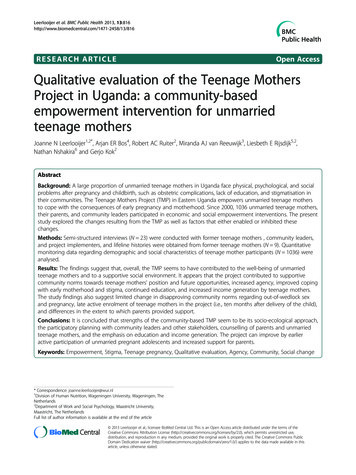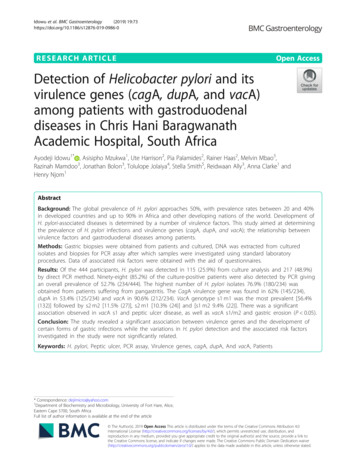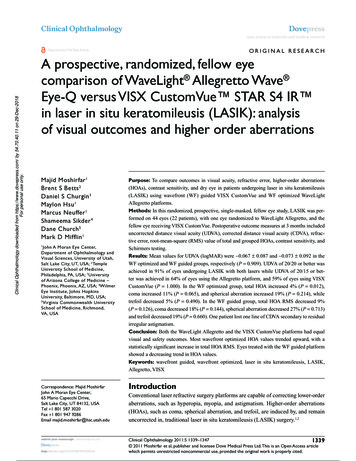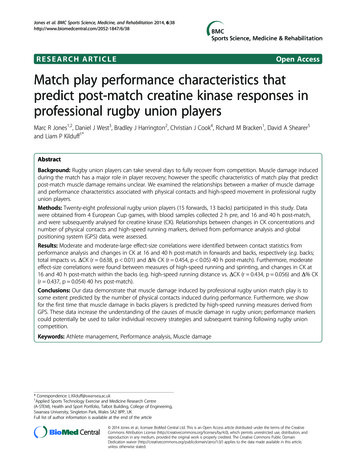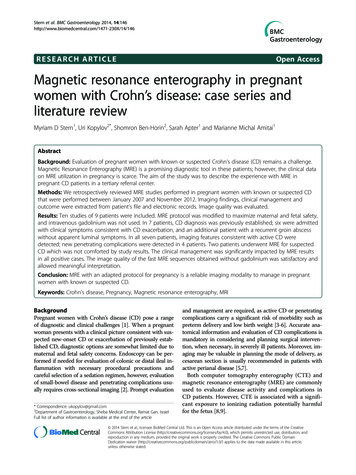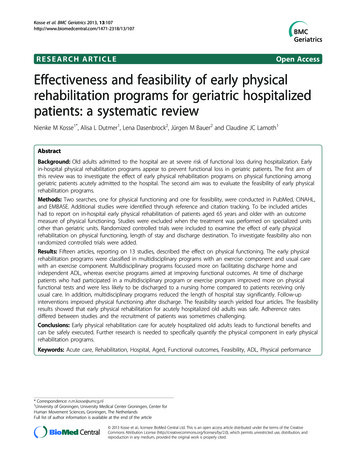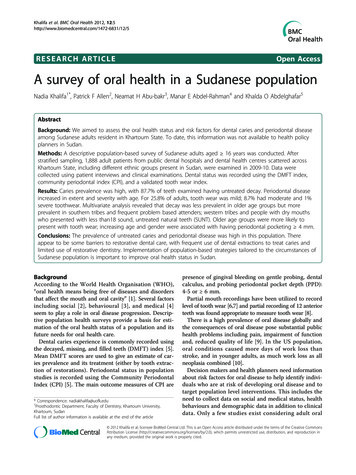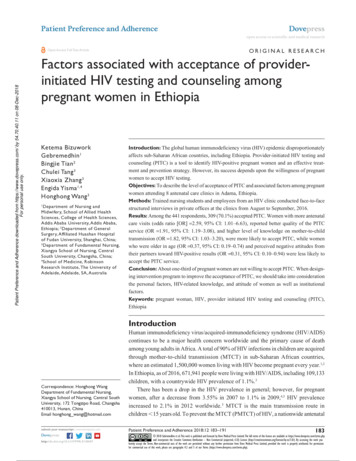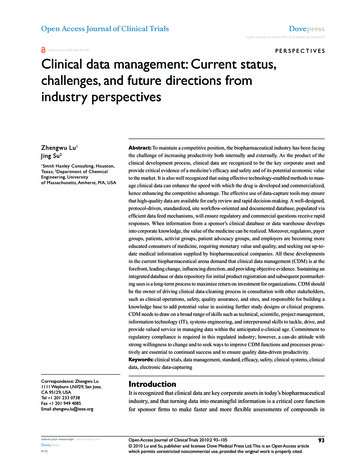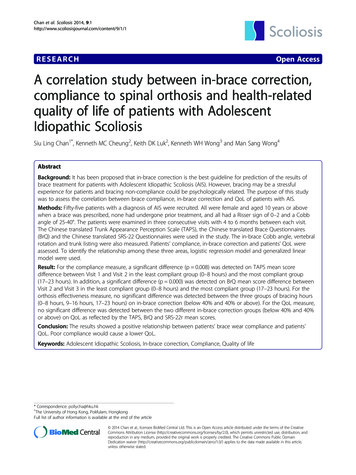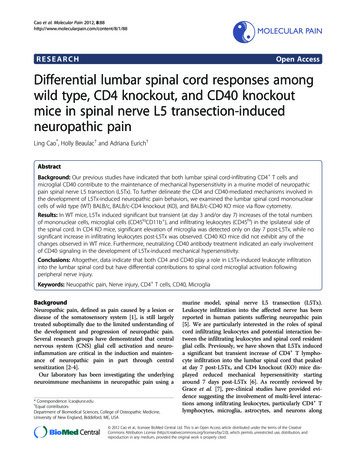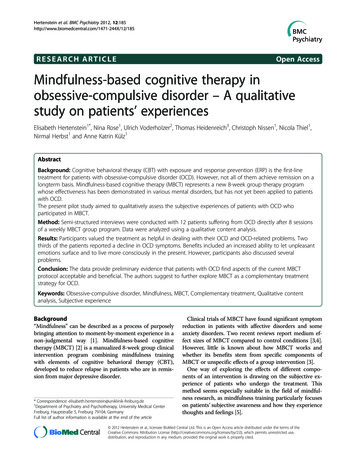
Transcription
Hertenstein et al. BMC Psychiatry 2012, 5RESEARCH ARTICLEOpen AccessMindfulness-based cognitive therapy inobsessive-compulsive disorder – A qualitativestudy on patients’ experiencesElisabeth Hertenstein1*, Nina Rose1, Ulrich Voderholzer2, Thomas Heidenreich3, Christoph Nissen1, Nicola Thiel1,Nirmal Herbst1 and Anne Katrin Külz1AbstractBackground: Cognitive behavioral therapy (CBT) with exposure and response prevention (ERP) is the first-linetreatment for patients with obsessive-compulsive disorder (OCD). However, not all of them achieve remission on alongterm basis. Mindfulness-based cognitive therapy (MBCT) represents a new 8-week group therapy programwhose effectiveness has been demonstrated in various mental disorders, but has not yet been applied to patientswith OCD.The present pilot study aimed to qualitatively assess the subjective experiences of patients with OCD whoparticipated in MBCT.Method: Semi-structured interviews were conducted with 12 patients suffering from OCD directly after 8 sessionsof a weekly MBCT group program. Data were analyzed using a qualitative content analysis.Results: Participants valued the treatment as helpful in dealing with their OCD and OCD-related problems. Twothirds of the patients reported a decline in OCD symptoms. Benefits included an increased ability to let unpleasantemotions surface and to live more consciously in the present. However, participants also discussed severalproblems.Conclusion: The data provide preliminary evidence that patients with OCD find aspects of the current MBCTprotocol acceptable and beneficial. The authors suggest to further explore MBCT as a complementary treatmentstrategy for OCD.Keywords: Obsessive-compulsive disorder, Mindfulness, MBCT, Complementary treatment, Qualitative contentanalysis, Subjective experienceBackground“Mindfulness” can be described as a process of purposelybringing attention to moment-by-moment experience in anon-judgmental way [1]. Mindfulness-based cognitivetherapy (MBCT) [2] is a manualized 8-week group clinicalintervention program combining mindfulness trainingwith elements of cognitive behavioral therapy (CBT),developed to reduce relapse in patients who are in remission from major depressive disorder.* Correspondence: ment of Psychiatry and Psychotherapy, University Medical CenterFreiburg, Hauptstraße 5, Freiburg 79104, GermanyFull list of author information is available at the end of the articleClinical trials of MBCT have found significant symptomreduction in patients with affective disorders and someanxiety disorders. Two recent reviews report medium effect sizes of MBCT compared to control conditions [3,4].However, little is known about how MBCT works andwhether its benefits stem from specific components ofMBCT or unspecific effects of a group intervention [3].One way of exploring the effects of different components of an intervention is drawing on the subjective experience of patients who undergo the treatment. Thismethod seems especially suitable in the field of mindfulness research, as mindfulness training particularly focuseson patients’ subjective awareness and how they experiencethoughts and feelings [5]. 2012 Hertenstein et al.; licensee BioMed Central Ltd. This is an Open Access article distributed under the terms of theCreative Commons Attribution License (http://creativecommons.org/licenses/by/2.0), which permits unrestricted use,distribution, and reproduction in any medium, provided the original work is properly cited.
Hertenstein et al. BMC Psychiatry 2012, 5Several studies have already examined how patients withmood and anxiety disorders experience MBCT, usingqualitative methodology. Finucane and Mercer [6]reported that a majority of thirteen patients with recurrentdepression, who were interviewed three months after thecourse, experienced MBCT as both acceptable and beneficial. Allen et al. (2009) studied twenty patients in full orpartial remission from major depressive disorder twelvemonths after MBCT. Four over-arching themes emergedfrom their data: control, acceptance, relationships andstruggle. Bailie, Kuyken and Sonnenberg [7] focused onMBCT’s impact on the parenting behavior of 16 participants with recurrent depression. Their results showed thatall but one participant continued mindfulness practiceover the course of one year. The authors observed thatmindfulness practice was accompanied by changes in participants’ interaction patterns with their children, such asan improved management of negative emotions in challenging situations, an increased ability to adopt their childrens’ perspective and an enhanced recognition of ownneeds. Another qualitative study by Chadwick et al. [8]indicated that patients with bipolar disorder might alsobenefit from MBCT. This mostly applied to a reduced impact of the current mood state and a higher acceptance ofmood changes. Making use of interpretative phenomenological analysis, Williams et al. [9] observed a beneficial effect of MBCT in patients with hypochondriasis, both withregard to symptoms of health anxiety and broader functioning. Yet, to date, there are no publications on experiences of patients with OCD who receive MBCT.OCD which is characterized by distressing intrusivethoughts and time-consuming compulsive rituals, is acommon psychiatric disorder with a lifetime prevalence of1 to 3% [10]. CBT including exposure and responseprevention (ERP) is the first-line treatment for OCD (e.g.[11,12]). Augmenting treatment with selective serotoninreuptake inhibitors (SSRI) is recommended for patientswithout overt compulsions, those who do not respond toCBT alone or those with comorbid major depression [13].However, in a recent investigation of an extensive therapyprogram including daily therapist-assisted exposure andresponse prevention exercises over a period of threeweeks, only 55% of the patients could be classified astreatment responders when response was defined as a decrease of symptom severity by at least 35% [14]. In a systematic review of psychological and pharmacologicaltreatment studies, it was found that symptoms persistedat a moderate level following adequate treatment [12].Due to the anxiety-provoking nature of ERP, patientsoften perceive the therapy as demanding. In MBCT, incontrast to ERP, patients are encouraged to observe unpleasant experiences as they arise and label them asthoughts, feelings or bodily experiences, but unpleasantexperiences are not provoked intentionally. In contrast toPage 2 of 10traditional cognitive therapy (CT) (see e.g. [15]) that aimsto identify and restructure maladaptive thoughts, MBCTrather targets the attitude towards thoughts, not their content. That is, in MBCT, patients are taught to carefully observe every arising thought, label it as a thought, try not tojudge it and refrain from acting on it compulsively.Supplementing existing evidence-based treatments withmindfulness-based interventions has repeatedly beenrecommended for patients with OCD, for example byDidonna and Fairfax [16,17]. Preliminary results point towards the efficacy of mindfulness-based treatments for thereduction of OC symptoms: In a quasi-experimental studyon students, a decline of subclinical OC symptoms wasobserved after a mindfulness based intervention [18]. Arandomized controlled trial has demonstrated that acceptance and commitment therapy (ACT), an interventionwhich employs mindfulness as well as a number of otherstrategies, is superior to relaxation training for patients withOCD and might produce a similar reduction in symptomsas CBT [19]. However, as ACT is not solely based on mindfulness but includes numerous other therapeutic interventions such as the clarification of values and committedaction, conclusions on the efficacy of mindfulness forpatients with OCD cannot be drawn from these results.The authors of a recent review concluded that mindfulnessholds promise as an intervention for the treatment of OCD,but the research in this area is still at a very early stage [20].It remains to be further elucidated whether MBCT as anadjunctive therapy to CBT with ERP might be useful to address some of the challenges mentioned above.The broad aim of our current research program is to investigate whether MBCT represents a feasible and effective, complementary treatment option for patients withOCD who are familiar with the principles of CBT including ERP. Here we report on a pilot study that appliesqualitative methodology to provide further insight into thesubjective experiences of OCD patients participating ineight group sessions of MBCT. Particularly, we investigated i) subjective changes of experience and behaviorwithin an eight-week period, ii) helpful and problematicaspects of MBCT and iii) suggestions for the adaptation ofthe program to the specific needs of patients with OCD.MethodsEthical approval and informed consentThe study was approved by the ethics committee of theAlbert Ludwig University Freiburg. Informed writtenconsent was obtained from each subject prior to theonset of the study.Study participantsSixteen subjects with OCD according to DSM-IV criteriawho had completed a behavioral therapy with ERP withina two-year period prior to the study were included. Four
Hertenstein et al. BMC Psychiatry 2012, 5subjects dropped out during the first three treatment sessions: one due to difficulties in scheduling appointments,another two because they re-initiated a behavioral therapy,and one in whom a traumatic brain injury was discovered.Twelve subjects completed the MBCT intervention andtook part in semi-structured interviews within two weeksafter the course. The analyzed sample (N 12) consistedof three women and nine men with a mean age of 41.8years (SD 12.4 years) who, on average, had suffered fromOCD for 19 years. At baseline, their average score was17.7 points (SD 8.1, range 7 to 28) on the Yale Brown Obsessive Compulsive Scale [21,22], a well established instrument measuring the severity of OCD. 17.7 points equal amoderate degree of OCD. The most commonly reportedmajor symptoms were concerns with dirt and contaminants and washing/cleaning compulsions. Exclusion criteria were the current diagnosis of a severe depressiveepisode, substance abuse, borderline personality disorder,current or past diagnosis of a psychosis and severe braininjury, as well as age outside the range of 18 to 65 yearsand current psychotherapeutic treatment. Diagnoses weremade by a trained psychologist according to DSM-IV criteria, using the Structured Clinical Interview for DSM-IV[23]. Six subjects were on medication, mainly selectiveserotonin re-uptake inhibitors. In all subjects, the medication status had been stable for at least ten months prior toinclusion. Three patients fulfilled criteria for a personalitydisorder, namely avoidant, histrionic and paranoid personality disorder.InterventionThe intervention program was adapted from “MBCT fordepression: a new approach to preventing relapse” asdescribed by Segal, Williams and Teasdale [2]. Cognitiveelements of the manual were adapted for OCD with theobjective of providing a preferably disorder-specifictreatment. Mindfulness elements were adopted from theoriginal manual. MBCT was delivered in eight twohour-sessions, once a week. Each session included briefreporting on the previous week, a review of weekly“homework” (mindfulness practice outside the sessions),guided in-session mindfulness practice and exchangewithin the group as well as a preview of the “homework”for the following week. After each session, participantswere given handouts with a summary of the most important session contents. They were also given two CDswith instructions for mindfulness exercises they couldpractice at home. Table 1 provides a summary of themajor learning objectives of MBCT and correspondingcontents of the course. OCD-specific interventions arehighlighted in bold type.MBCT trainers (NR, AKK) were experienced cognitivebehavioral therapists with several years’ expertise inmindfulness practice. They had been trained by one ofPage 3 of 10the founders of MBCT, Mark Williams. Sessions werevideotaped and supervision was provided by TH.Data collection and analysisInterviews and data analysis were conducted by a staffmember experienced in the area of OCD who was familiar with the MBCT manual. Based on an extensive literature search, a semi-structured interview schedule wasdeveloped by the workgroup, covering the main and secondary research questions. The interview schedule consisted of the following questions:1) When you think about the past eight weeks and themindfulness program, what comes to your mind?2) Did you notice any kind of changes over the pasteight weeks?3) How did you experience mindfulness?4) Do you think that mindfulness was helpful regardingyour OCD?5) Did you experience any difficulties?6) If you could change anything about the program,what would you change?Due to the fact that hardly any literature is availableon subjective experiences of patients with OCD undergoing mindfulness training, the interview schedule wasused only to roughly structure conversations, allowing todigress into other topics brought up by the participants(in accord with Smith, [24]). Each interview lasted approximately 30 minutes and was videotaped, or, in twocases, audiotaped, as participants refused beingvideotaped.For data analysis, an inductive data-driven approach waschosen. It allows the extraction of core themes, as recommended for example by Hsieh and Shannon [25] for cases“when existing theory or research literature on aphenomenon is limited”, and in line with previous studieson similar research questions (e.g. [6,8]). Precisely, qualitative content analysis following Mayring [26] was selectedbecause it is a widely and successfully used method (compare e.g. [27,28]) and because it was considered a rathereconomic technique, compared for example to groundedtheory. Based on principles and techniques suggested byMayring [26], a multistage analytic strategy was developed:First, video- and audiotapes were transcribed verbatim. Inthe course of reading and re-reading transcripts, text passages that appeared to be relevant with regard to the research questions were extracted and coded, i.e. labeled asa term preferably close to the text passage itself. Furtherrelevant text passages were either subsumed under anexisting term or, whenever they did not fit into an existingcategory, assigned a new term. In this vein, the first seventranscripts were coded. The emerging system of categorieswas then discussed in an audit within the working group
Hertenstein et al. BMC Psychiatry 2012, 5Page 4 of 10Table 1 Major learning objectives of MBCT and course contentsObjectiveCourse contentsBecoming familiar with somecharacteristics of the mindintroducing “the autopilot” as a symbol for a state of mindlessnessExploring new ways of refocusing attentionand challenging dysfunctional meta-cognitive beliefsthe “body scan”, a 45-minute mindfulness exercise teaching participantsto attentively and non-judgmentally become aware of their body and body sensationsintroducing “the spectacles of OCD” as a symbol for selectiveinformation processing and cognitive distortionyoga exercisesdealing with arising thoughts and feelings during sitting meditation exercisesthe three-minute-breathing-space, a short exercise in which patients are invitedto focus their attention on their breathing and present momentary experiences,shifting from a “doing-mode” to a “being-mode” of minddiscussing the cognitive model by Salkovskis, emphasizing the impact ofthe subjective appraisal of thoughtsdiary of positive and negative eventsdiscussing neurobiological correlates of OCD to encourage disidentificationwith obsessive thoughts and impulsesFreeing oneself from dysfunctional habits andbeing kind with oneselfidentifying individual OCD triggersencouraging participants to perform the three-minute-breathing-spacewhenever they notice obsessive thoughts and impulsessharing poems, short stories and metaphors in order to invite participants toexperience thoughts as passing events of the mind rather than reflections of realityRelapse preventionestablishing individual schemes for dealing with difficult situationssetting objectives for goal-oriented behaviorintegrating pleasant activities into everyday livesOCD-specific contents are highlighted in bold type.and partially revised. Subsequently, the remaining fiveinterviews were coded. The resulting system of numerouscategories, which still closely matched the verbatim data,was again revised following discussions within the workgroup. Similar categories were grouped to extract a smaller number of abstract, overarching themes. Qualitativecontent analysis resulted in a system of five categories andseveral subcategories which were assumed to sufficientlyrepresent the data material.In order to bolster the qualitative reports with data fromanother source, we administered a self-developed questionnaire assessing the frequency of mindfulness practiceand the participants’ satisfaction with the individual mindfulness exercises (body scan, sitting meditation, yoga,three-minute breathing-space). Every treatment completerfilled in the questionnaire immediately after the lastMBCT session. The patients were asked how many MBCTsessions they had attended, how often they had practicedmindfulness outside the sessions, and were requested torate every mindfulness exercise on a five-point Likert scaleranging from “very helpful” to “not at all helpful”.they had in one way or another experienced it as an enrichment to their lives. Five overarching categories, threeof them divided into two subcategories each, emergedfrom the data analysis. Due to the semi-structured styleof the interviews, not every participant commented onevery theme. Table 2 summarizes the categories andsubcategories (subcategories in italics) and shows thenumber of patients who commented on the respectivethemes.Two of the five categories, namely “benefits” and“struggle”, will be described in more detail and will beillustrated using quotations from the interviews. Thesetwo categories were chosen because patients’ experiences of benefits and struggles in the context of MBCTappear to be of particular clinical interest. Patients’reports about the other participants and the MBCT trainers, in contrast, reflect unique characteristics of ourstudy setting. Please note that quotations have beentranslated from German to English. The statementshave been minimally edited to retain the raw, spontaneous nature of the original but also make for smootherreading.ResultsQualitative reportsBenefitsAll 12 treatment completers appreciated the program as awhole, were glad they had participated and stated thatNine participants stated that during MBCT they had become acquainted with a new way of dealing with their
Hertenstein et al. BMC Psychiatry 2012, 5OCD. One patient described how he managed to reducehis washing compulsions with the help of a mindfulnesstechnique:“When this urge comes, like let’s say, I want tostep out right now and wash my hands, that Ithen first pause for a second and remind myself toalso be mindful with myself, that I then say – in thepast I would have usually just bolted off rightaway – and now when I first pause for a moment,this has been an important word for me duringthese eight weeks, an important insight, then I cansay, yes, just kinda like it says in your book or inthese scripts, then I can say I will finish this herefirst and after half ‘n hour this impulse to leavemaybe doesn’t appear at all anymore, and if it doesI’ve still accomplished something, at least that‘show I feel about it.”Page 5 of 10Another participant found the three-minute breathingspace especially helpful in dealing with his compulsiverituals:“Well, like, you know, in some stressful situations, orwhen I, you know, thought that ok, now I shouldactually act all compulsive, well, then I just have, forexample, well, that I’ve just frequently applied thisthree-minute breathing space. Well, also to find out,what do I actually really want? And, do I have to do itnow, or. . . Then, sometimes I nonetheless acted outthe compulsion, but not as long as I used to, well, likebefore I took the program. Looking at it this way, itreally did a lot for me. Yes. And it, like, also distractsyou. Because then my thoughts aren’t on thecompulsion anymore, but rather first on like: Wheream I right now, what am I doing, and why. That wasactually good, yeah.”Table 2 System of five overarching themes that emerged from qualitative content analysisThemeN summaryOther participants10Prior to the course, six participants had been doubtful regarding the group format.Over the course of the program, however, a sincere and trusting atmosphere developedand participants experienced the exchange with others as helpful. Connecting with the otherparticipants affected by OCD served as an important self-validating experience.MBCT trainers11Trainers were rated as authentic, committed and professional. Participants could especiallybenefit from the trainers’ own personal experiences with mindfulness that were repeatedlyreported during the sessions.Evaluation. . .8Three participants found the three-minute-breathing-space especially helpful. Patients liked thatmindfulness exercises were not performed with a defined goal in mind, and that it was said thatwandering of the mind is a natural process. One participant distinguished outer and inner mindfulness,and found exercises referring to outer mindfulness especially helpful. . .practical implementation10The three-minute-breathing space was perceived as particularly feasible, whereas it was difficult toimplement the longer exercises into everyday life. The bodyscan and the yoga exercises were oftenconducted before going to bed, in order to come to rest. Waiting periods were experienced as convenientfor practicing mindfulness. Several participants have slightly modified the exercises to fit their own needs.benefits11Nine participants described new strategies they had learned to deal with their OCD, most of them resultingin an increased ability to refrain from compulsive rituals. Reported benefits furthermore included an increasedwillingness to experience unpleasant emotions and insights into the nature of the mind, living more activelyin the present moment, a calmer attitude, improved mood and improved sleep.undesired outcomes6Four participants stated that regarding their OCD, the course had not been helpful. One patient repeatedlyexperienced a highly unpleasant state performing the body scan. Another participant suffered from theexperience that compared to the other patients in the program, he was far more severely affected with OCD.Struggle11Three participants described that OCD symptoms repeatedly conflicted with their mindfulness practice,making it difficult to get themselves into the exercises. Whereas most participants found it rather easyto do a three-minute-breathing-space at a previously defined time, a common difficulty was to rememberthe exercise early enough in difficult situations related to OCD. Further difficulties included dealing withone’s expectations regarding mindfulness as a fast “cure”, as opposed to being a fairly long-term, fundamentalapproach.Modifications9Participants’ ideas to modify MBCT mainly concerned the length of the program: Several attendees suggestedto either extend the length of the individual session beyond 120 minutes, or to add further sessions.One participant proposed to schedule longer meditation exercises towards the middle of the sessions, as hefound it difficult to engage in meditation directly after arrival.Being in a groupMindfulness ExercisesEffectsN number of patients who commented on the respective theme. Subthemes are written in italics.
Hertenstein et al. BMC Psychiatry 2012, 5A participant who predominantly suffered from obsessions with aggressive and sexual content also successfully used mindfulness techniques:“Well, and it is like simply ‘n alternative tosuppressing and to “obsessively”, yeah “obsessively”thinking of positive things. Well, which just uses upan insane amount of energy, too. And this stayingmindful, and then just saying what is actually goingon right now, just seems to make a lot more sense tome. Well, I notice that this is definitely a very goodway. Maybe even the only one that exists that couldreally help. But it requires a great deal of practice, andyou have to, how should I say, constantly makeyourself aware of it and also tell yourself all the timeok now stay here, don’t chase your thoughts, just letthem pass by. This works. It works, but it’sstrenuous.”For this patient, information and discussion about thenature of the mind and thoughts were of particularinterest. Realizing that having sudden unpleasant, intrusive thoughts is a common phenomenon known not justto patients with OCD but to most people, meant a greatrelief to him and made it easier for him to observe hisobsessions without judging himself for their occurrence.Accordingly, he tried to mindfully watch obsessivethoughts come and go, to make them out as obsessionsand then to bring his attention back to the present moment. A woman affected by dirt- and blood- relatedobsessions as well as washing and cleaning compulsionsexplained that being mindful leads to a decreased occurrence of obsessions:“Of course, because, when I go shopping, just as anexample, I go shopping. And then, everything else isnot important in that moment. I just go shopping andfocus on that. Well that’s how I feel about it now. If Ireally put myself into that, then there is not muchspace for other things.”Furthermore, the patients reported an increased willingness to tolerate even unpleasant emotions when performing mindfulness meditation. Three participantsreported that feelings such as sadness and pain occurredduring the body scan. All of them stated that they hadbeen able to let these feelings surface without trying tochange them or get rid of them. Four participantsreported that MBCT had taught them to live more actively in the present moment. Consequently, they perceived a reduced tendency to ruminate and worry aswell as an increased ability to engage in pleasant activities and to value these experiences. One patient notedthat whilst MBCT had not helped her to reduce herPage 6 of 10obsessions and compulsions, she experienced herself asreacting calmer even in difficult situations, more capableto accept her OCD as a part of her life and as being ableto enjoy her life despite her struggle with OCD. Last butnot least, some participants specifically used mindfulnessexercises before going to bed and reported a positive impact on their sleep.StruggleThree participants reported that OCD symptoms considerably interfered with their mindfulness practice duringand beyond the sessions. One patient stated that at thebeginning of the program it had been extremely challenging just to sit in a room together with the other participants because, as she stated, “every breath of air wasOCD”. By the end of the course, however, she noticedthat considerably fewer counting compulsions occurredduring the sessions. She reported that during the eightweeks it had become easier for her to restrain herselffrom engaging in rituals, though she was still afflictedwith several obsessive concerns. Another participant suffered from extensive mental compulsive rituals. Moreprecisely, he felt the urge to mentally repeat everythingthat he or others had said. Consequently, he found it extremely difficult to stop himself from repeating the trainers’ instructions over and over during mindfulnessexercises. Three patients found it especially challengingto use mindfulness techniques such as the three-minutebreathing space as a skill in difficult situations related toOCD. One participant explained that he experienced hiscompulsions as a highly automatized behavior – he repeatedly caught himself in the act, becoming aware thenthat he had not been able to mindfully notice an obsessive urge before engaging in a compulsive ritual. Threemore participants found the mismatch between theirwish to get rid of their OCD as fast as possible andmindfulness being a long-term process troubling. Adding to this is that mindfulness initially does not appeargoal-oriented. One participant phrased it this way:“On a mental level, I sometimes have problems that Istart thinking, with the body scan, and so on: Andthat’s it now? One somehow always expectssomething to happen immediately. But here, that’s justit for the moment, and let it sink. Yes. That youshouldn’t hang your hopes so - basically not to haveany expectations at all, I think this seems to be theimportant point. Rather, it just happens automatically.And you have to be patient there, with yourself.”RatingsOf a total of twelve treatment completers, four attendedall eight MBCT sessions, five missed one session andthree missed two. Two participants indicated that they
Hertenstein et al. BMC Psychiatry 2012, 5had practiced mindfulness outside the sessions six toseven times per week. Five participants reported thatthey had practiced four to five times and the fiveremaining participants had practiced two to three times.Concerning the ratings of satisfaction, the threeminute-breathing space received the most favorable ratings: nine out of twelve participants reported that thisexercise was “very helpful” for them and one participantrated it as “quite helpful”. Eight patients found the bodyscan very or quite helpful, seven said this about the sitting medita
episode, substance abuse, borderline personality disorder, current or past diagnosis of a psychosis and severe brain injury, as well as age outside the range of 18 to 65 years and current psychotherapeutic treatment. Diagnoses were made by a trained psychologist according to DSM-IV cri-teria,
